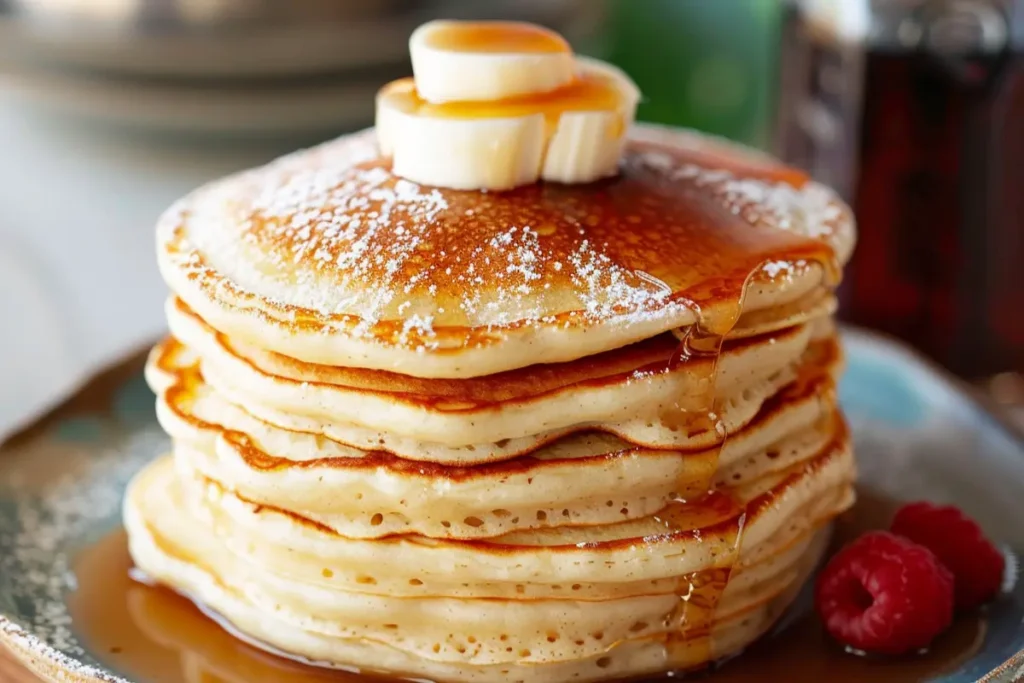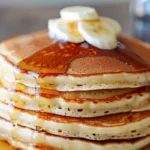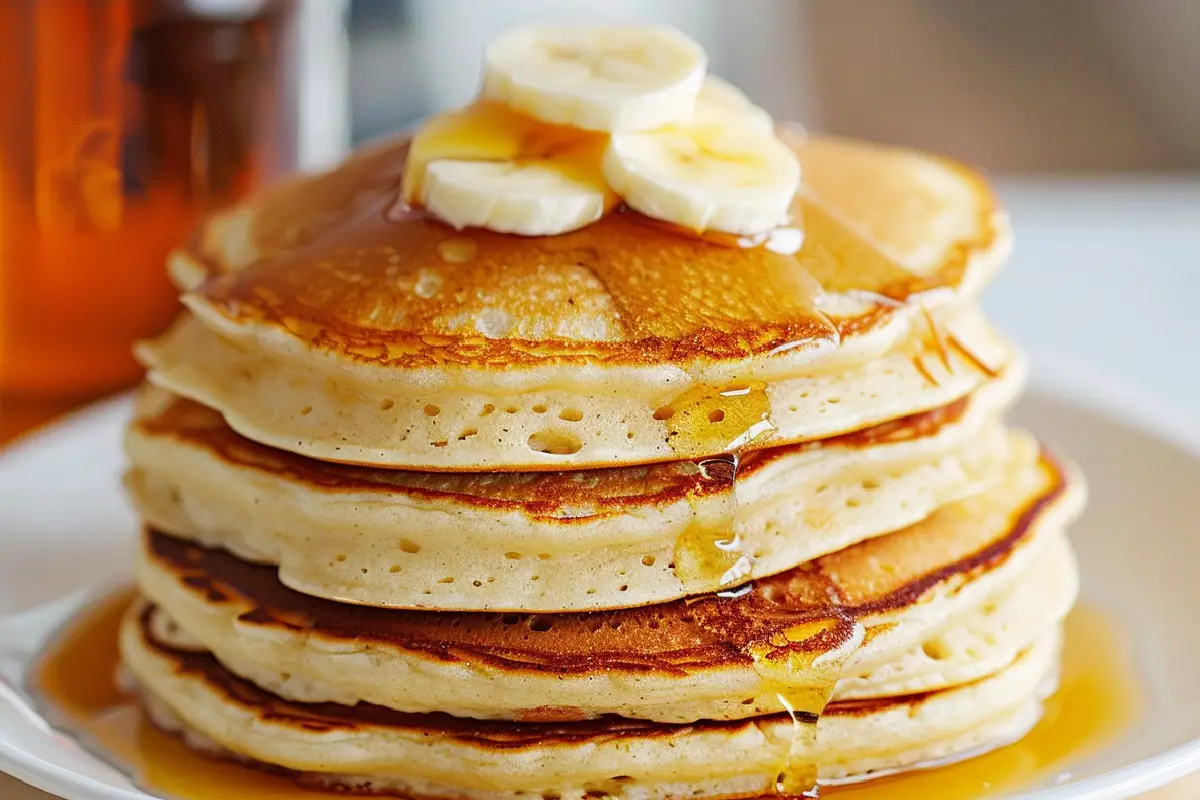Table of Contents: What can I use instead of milk in pancakes?
Introduction: What can I use instead of milk in pancakes?
Who hasn’t woken up craving a stack of fluffy, golden pancakes, only to realize—uh-oh—you’re out of milk? Don’t worry, you’re not alone! Pancakes are a breakfast staple loved for their soft, buttery texture and versatility. But what if you’re dairy-free, lactose intolerant, or simply ran out of milk? The good news is, you don’t have to skip pancake day!
In this guide, we’ll explore the best milk substitutes for pancakes that keep them just as light, fluffy, and delicious. Whether you’re using almond milk, yogurt, or even soda (yes, really!), these swaps ensure you never miss out on a perfect breakfast.
Like our popular “3-Ingredient Banana Pancakes”, this recipe proves that simple ingredients can create something amazing. So grab your whisk, and let’s make dairy-free pancakes so good, no one will guess the secret!
What Can I Use Instead Of Milk In Pancakes?

Ever stared into your fridge, wondering, “What can I use instead of milk in pancakes?” You’re not alone—this is a kitchen dilemma as old as time (or at least as old as pancakes themselves). Some say pancakes got their name from being cooked in a pan, but we like to think it’s because they’re the ultimate pan-acea for hunger!
As the old saying goes, “The way to a man’s heart is through his stomach,” and honestly, the way to anyone’s heart is through a stack of warm, syrup-drenched pancakes. So, if you’re out of milk, don’t panic—just try one of these genius swaps and keep the flapjack love alive!
Why You’ll Love These Dairy-Free Pancakes
- Fluffy & Delicious – No milk? No problem! These substitutes keep pancakes light and tender.
- Budget-Friendly – Use pantry staples like water, yogurt, or oat milk instead of buying dairy.
- Customizable Flavors – Swap in almond milk for nuttiness or coconut milk for a tropical twist!
If you loved our “Easy Vegan Pancakes“, you’ll adore these simple, dairy-free alternatives. Ready to flip the best pancakes ever? Let’s go!
How to Make Pancakes Without Milk
Quick Overview
✔ Prep Time: 5 mins
✔ Cook Time: 10 mins
✔ Total Time: 15 mins
✔ Difficulty: Easy
✔ Key Feature: Just as fluffy as traditional pancakes!
Key Ingredients
- 1 cup all-purpose flour
- 1 tbsp sugar
- 2 tsp baking powder
- ¼ tsp salt
- 1 egg (or flax egg for vegan)
- 1 cup milk substitute (see options below)
- 1 tbsp melted butter or oil
Step-by-Step Instructions
- Mix Dry Ingredients – Whisk flour, sugar, baking powder, and salt in a bowl.
- Add Wet Ingredients – Pour in your milk substitute, egg, and melted butter. Stir until just combined (small lumps are okay!).
- Cook Pancakes – Heat a non-stick pan over medium heat. Pour ¼ cup batter per pancake and cook until bubbles form (about 2 mins). Flip and cook another 1-2 mins.
- Serve Warm – Top with syrup, fruit, or chocolate chips!
5 Best Milk Substitutes for Pancakes
- Almond Milk – Light, slightly nutty, and perfect for vegan pancakes.
- Yogurt + Water – Thick and tangy, adds extra fluffiness.
- Oat Milk – Creamy and neutral, great for binding.
- Coconut Milk – Rich and tropical, best for thicker batter.
- Soda Water – Surprise! Adds airy lightness (use less sugar).
What to Serve With Pancakes
- Fresh berries & whipped cream
- Crispy bacon or sausage
- A drizzle of honey or Nutella
- A side of scrambled eggs
Top Tips for Perfect Pancakes
✔ Don’t Overmix – Lumpy batter = fluffier pancakes.
✔ Medium Heat – Too hot burns the outside before the inside cooks.
✔ Rest the Batter – Let it sit 5 mins for extra rise.
Storing & Reheating Tips
- Fridge: Keep in an airtight container for up to 3 days.
- Freezer: Stack with parchment paper between layers; freeze for 1 month.
- Reheat: Warm in a toaster or microwave for 30 secs.
FAQs: What can I use instead of milk in pancakes?

Q: Can I use water instead of milk in pancakes?
A: Absolutely! Water works in a pinch, but for richer flavor, try adding a bit of melted butter or vanilla extract.
Q: What’s the best non-dairy milk for fluffy pancakes?
A: Oat milk and almond milk are top choices—they add creaminess without overpowering the taste.
Q: Can I make pancakes without eggs AND milk?
A: Yes! Use a flax egg (1 tbsp ground flaxseed + 3 tbsp water) and any milk substitute for vegan pancakes.
Q: Why did my pancakes turn out dense?
A: Overmixing the batter or using a heavy substitute (like thick yogurt without thinning it) can make pancakes dense.
Q: Can I use juice instead of milk in pancakes?
A: It’s possible (orange juice adds a fun twist!), but the acidity might affect rise. Stick to neutral liquids for classic fluffiness.
Conclusion: What can I use instead of milk in pancakes?
Running out of milk doesn’t mean giving up on pancakes—it just means getting creative! Whether you opt for almond milk’s nutty hint, yogurt’s tangy fluffiness, or even bubbly soda water for ultra-light pancakes, these substitutes ensure your breakfast stays delicious.
The best part? Many of these swaps are pantry staples, so you’re always ready for a cozy pancake morning. Next time someone asks, “What can I use instead of milk in pancakes?” you’ll have five foolproof answers (and maybe even a secret sixth—like coffee for mocha pancakes!).
Now it’s your turn! Have a favorite milk substitute we didn’t mention? Tag us in your pancake pics on Instagram—we’d love to see your stacks. Happy flipping! 🥞💛
Print
Fluffy Homemade Pancakes
- Total Time: 25 mins
- Yield: 8–10 pancakes 1x
- Diet: Vegetarian
Description
Fluffy homemade pancakes that melt in your mouth! This easy recipe makes perfect golden-brown pancakes every time – light, airy, and delicious with your favorite toppings.
Ingredients
- 1 ½ cups all-purpose flour
- 3 ½ tsp baking powder
- 1 tbsp granulated sugar
- ½ tsp salt
- 1 ¼ cups milk (or milk alternative)
- 1 large egg
- 3 tbsp melted butter (plus extra for cooking)
- 1 tsp vanilla extract (optional)
Instructions
- In large bowl, whisk together flour, baking powder, sugar and salt
- In another bowl, beat milk, egg, melted butter and vanilla
- Pour wet ingredients into dry ingredients, stir until just combined (batter will be slightly lumpy)
- Heat griddle or pan over medium heat, lightly butter
- Pour ¼ cup batter per pancake
- Cook until bubbles form on surface (2-3 minutes), then flip
- Cook other side until golden brown (1-2 minutes)
- Serve warm with maple syrup and butter
Notes
- For fluffier pancakes: Let batter rest 5 minutes before cooking
- For dairy-free: Use almond milk and coconut oil
- For buttermilk pancakes: Add 1 tbsp lemon juice to milk and let sit 5 minutes
- Don’t overmix – lumps are good!
- Prep Time: 10 mins
- Cook Time: 15 mins
- Category: Breakfast
- Method: Stovetop
- Cuisine: American
Nutrition
- Serving Size: 1 pancake
- Calories: 120
- Sugar: 2g
- Sodium: 220mg
- Fat: 4g
- Saturated Fat: 2g
- Unsaturated Fat: 1g
- Trans Fat: 0g
- Carbohydrates: 18g
- Fiber: 0.5g
- Protein: 3g
- Cholesterol: 30mg
Keywords: fluffy pancakes, homemade pancakes, easy pancake recipe, breakfast recipes, weekend brunch

